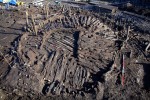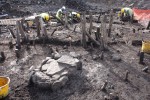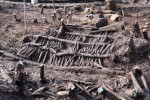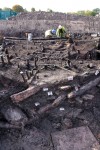 An archaeological dig of a crannog (an artificial island built in a lake or river) in County Fermanagh in the northern Irish province of Ulster has revealed a wealth of artifacts and exceptionally well-preserved wooden structures dating as far back as 900 A.D. This is the first thorough scientific excavation of a crannog in Ulster and it almost didn’t happen at all.
An archaeological dig of a crannog (an artificial island built in a lake or river) in County Fermanagh in the northern Irish province of Ulster has revealed a wealth of artifacts and exceptionally well-preserved wooden structures dating as far back as 900 A.D. This is the first thorough scientific excavation of a crannog in Ulster and it almost didn’t happen at all.
Although Drumclay Crannog, long since filled in and no longer a discernible island in Loch Erne, had been marked on surveys and maps going back to the 19th century, its precise location was unclear. In 2007, the Roads Service began planning construction of a new highway link road outside of the county town of Enniskillen near the crannog. They did some rudimentary surveys of the planned route but the archaeologists they send to walk the area couldn’t pinpoint the crannog due to waterlogged conditions and limited access. The Department of Regional Development clearly stated in its notice of intent to build that the construction would harm the archaeological site, even if it didn’t cross exactly over it. To mitigate the damage, the department said the crew would be really careful stripping topsoil and would be sure to record all archaeological finds so they’d be fully documented before they were destroyed.
 In 2011, once it had built a temporary stone haul route over the crannog, the construction company employed archaeologists to dig a single exploratory trench. They confirmed the exact location of the crannog (just slightly north of where it had been marked on the ordnance maps) and that it was a rich archaeological site with extensive structural remains and artifacts. Now the Road Service decided to preserve the site in situ by filling the perimeter with rocks and building a bridge over it rather than putting a road in its place, but in April 2012 it became clear that the heavy machinery and construction work in the area was draining the water-logged land. The crannog began to collapse outward. Road stone was dumped around it in an attempt to keep the island and its stratigraphy stable, but the stones sank like so many Monty Python Swamp Castles.
In 2011, once it had built a temporary stone haul route over the crannog, the construction company employed archaeologists to dig a single exploratory trench. They confirmed the exact location of the crannog (just slightly north of where it had been marked on the ordnance maps) and that it was a rich archaeological site with extensive structural remains and artifacts. Now the Road Service decided to preserve the site in situ by filling the perimeter with rocks and building a bridge over it rather than putting a road in its place, but in April 2012 it became clear that the heavy machinery and construction work in the area was draining the water-logged land. The crannog began to collapse outward. Road stone was dumped around it in an attempt to keep the island and its stratigraphy stable, but the stones sank like so many Monty Python Swamp Castles.
![]() In June 2012, the Northern Ireland Environment Agency determined that the crannog had to be excavated before it was too late. A small group of contract archaeologists hired by the construction company were given six weeks to do what they could. They had limited tools, no storage facility for keeping organic artifacts in proper conditions, poor recording and sampling practices. Meanwhile construction was still going on all around them. The discoveries were already remarkable — leather clothing, human remains, the foundation of a rare double-walled wattle house — but with the deadline looming and the damage ongoing, things looked bad for the crannog.
In June 2012, the Northern Ireland Environment Agency determined that the crannog had to be excavated before it was too late. A small group of contract archaeologists hired by the construction company were given six weeks to do what they could. They had limited tools, no storage facility for keeping organic artifacts in proper conditions, poor recording and sampling practices. Meanwhile construction was still going on all around them. The discoveries were already remarkable — leather clothing, human remains, the foundation of a rare double-walled wattle house — but with the deadline looming and the damage ongoing, things looked bad for the crannog.
Members of the crew contacted archaeologist Robert M. Chapple who got the word out on his blog and in the press. The subsequent outcry spurred Minister of the Environment Alex Attwood to impose a construction exclusion zone around the archaeological site, to extend the excavation another eight weeks and to appoint an independent reviewer to investigate how this debacle had come about. In response to their letters of protests, Attwood assured the Institute for Archaeologists, that he was taking a personal interest in the site, that he had assigned additional staff to the project, including an environmental archaeologist to oversee the sampling strategy and a wood specialist to help with the identification and preservation of organic materials.
 Those additional eight weeks of excavation have turned into five months and what glorious ones they have been. Archaeologists have discovered that, contrary to previous estimates that put the age of the crannog at about 700 years old, people lived there from at least 900 A.D. to 1600. The extensive preserved structures of small but well-appointed houses indicate the crannog was home to one noble family whose scions and servants lived in four or five houses at any given time. They were adept at woodwork and metal work, grew their own crops and butchered their own meat. They also spun wool from their own sheep to make their clothes.
Those additional eight weeks of excavation have turned into five months and what glorious ones they have been. Archaeologists have discovered that, contrary to previous estimates that put the age of the crannog at about 700 years old, people lived there from at least 900 A.D. to 1600. The extensive preserved structures of small but well-appointed houses indicate the crannog was home to one noble family whose scions and servants lived in four or five houses at any given time. They were adept at woodwork and metal work, grew their own crops and butchered their own meat. They also spun wool from their own sheep to make their clothes.
Some of the most striking finds are, a wooden bowl with a cross carved into its base, a unique find from an excavation in Ireland, parts of wooden vessels with interlace decoration, and exquisite combs made from antler and bone, status symbols that date to between 1000 and 1100 AD.
Other finds include what is believed to be the largest collection of pottery from a crannog in Northern Ireland, as well as ornaments of iron, bronze and bone.
As the site had been waterlogged, a huge volume of wooden remains have been found, from gaming chess-like pieces, to drinking cups right through to the timber foundations of dozens of houses.
Parts of at least two different log boats have been discovered, and a wooden oar – from deposits several centuries older than the boats – has also been found.
Some of the combs are similar to others found in Dublin and York and dating to Viking times.
Archaeologists have also discovered leather shoes, agricultural equipment, knives and decorated dress pins.
The archaeological dig is now scheduled to conclude on December 30th, but there are still unexplored layers. The 900 A.D. date comes from the dating of pottery found on the site. As they go lower down in to the stratigraphy, archaeologists are likely to find evidence of even earlier habitation.
 On Saturday, December 1st, the Drumclay Crannog will host an open day. From 9:30 AM to 3:00 PM, the public will be allowed to view the site from above, see the artifacts and meet the archaeologists. The tours will be guided and space is limited, so if you have the chance, call 028 6632 5000 to book your place now.
On Saturday, December 1st, the Drumclay Crannog will host an open day. From 9:30 AM to 3:00 PM, the public will be allowed to view the site from above, see the artifacts and meet the archaeologists. The tours will be guided and space is limited, so if you have the chance, call 028 6632 5000 to book your place now.
Apparently the road will eventually be built over the crannog as per the original plan, but I’m holding out hope that the unique historical significance of this site will keep it in the news and out of the hungry maws of steam shovels.